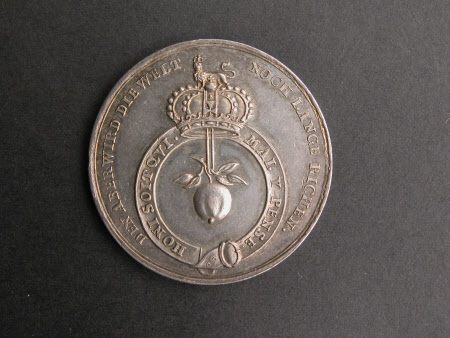The death of Queen Mary II (1662-1694)
Category
Coins and medals
Date
1695
Materials
Silver
Measurements
382 mm (Diameter)
Place of origin
Germany
Order this imageCollection
Osterley Park and House, London
NT 773281
Summary
Silver, medal commemorating the death of Queen Mary II (1662-94), struck Germany, 1695. A silver medal made in Germany to commemorate the death of Queen Mary II (1662-94), on 28 December 1694 old style (7 January 1695 new style). The obverse shows two flags, each decorated with a rose. One is flying, the other droops. The German legend reads ‘One of these roses is faded’ and, in the exergue, ‘Mary Queen of England died on 7 January 1695’. On the reverse is the Garter, surmounted by a Crown, from which is suspended an orange. The German legend reads ‘This [the orange] will the world long smell’.
Full description
Mary was the eldest daughter of the Duke of York, the future King James II/VII (1633-1701) and his first wife Anne Hyde (1637-71). Her sister was the future Queen Anne. Since Mary’s uncle King Charles II had no legitimate children, Mary was from childhood second in line to the throne after her father. She and Anne were brought up as Protestants according to the instructions of Charles II, so did not share the religious views of their father, who had converted to Catholicism in the late 1660s. In 1677 Mary married her cousin William III of Orange, moving with him to the Netherlands. After the Glorious Revolution of 1688, Mary moved back to Britain and reigned jointly with her husband, acting as sole Regent when he was away on campaigns (NT 773278). She died late in 1694 after having contracted smallpox. As she and William had remained childless, the succession devolved upon Mary’s sister Anne. Although Mary was the target of vicious propaganda from the Jacobites and was sometimes regarded as deferring too much to her husband, William in fact depended much on her for advice and was devastated by her death. Mary won general respect from many as a quiet, capable and wise monarch. A significant number of medals were issued to mark the death of Queen Mary II (for other examples, see NT 773280, 773282-283). This medal was made in Germany, where the Protestant states regarded Britain and the Netherlands as the most important bulwarks of their religion in Europe. The meaning of the obverse is that although one part of the dual monarchy may have died, the other part, King William III, remains. The reverse also emphasises the enduring strength of the House of Orange in Britain, symbolised by the royal Crown and the Garter, the symbol of Britain’s principal order of chivalry. Jeremy Warren 2019
Provenance
Given to the National Trust in 1993 by George Child Villiers, 9th Earl of Jersey (1910-1998).
Marks and inscriptions
Obverse, legend: DIE EINE DISER ROSEN IST VERBLICHEN. Obverse, exergue: MARIA. K. VON. ENGELLAND. STIRBT D. 7. IAN. 1695. Reverse, legend: DEN ABER WIRD DIE WELT NOCH LANGE RICHEN. Reverse, on garter belt: HONI SOIT QVI. MAL Y PENSE.
References
Hawkins, Franks and Grueber 1885: Edward Hawkins, Augustus W. Franks and Herbert A. Grueber (eds.), Medallic Illustrations of the History of Great Britain and Ireland to the death of George II, 2 vols., London 1885, vol. II, pp. 120-21, no. 363.
